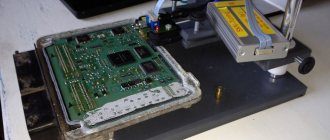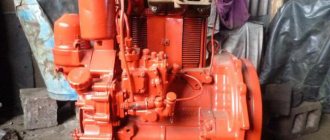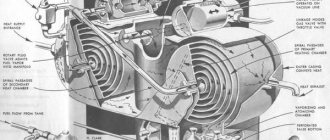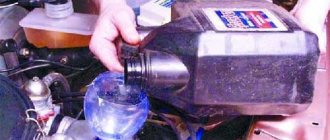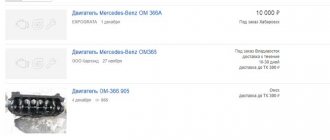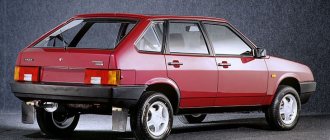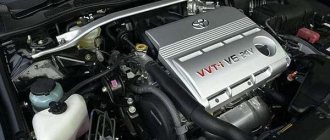Niva engine
Below is a list with a detailed description of the characteristics installed on the Niva with an index starting with 2121 and onwards. All Niva engines have an 8-valve engine with chain timing drive.
Engine 2121
The Niva got this internal combustion engine from the VAZ 2106, but, of course, it was modernized. Its volume was increased to 1.6 liters, which made it possible to remove a large amount of horsepower from the engine, which is so necessary for all-wheel drive. The engine was equipped with a two-chamber carburetor of increased volume, which also had a positive effect on the technical characteristics of the car. This engine was installed virtually unchanged until 2005; in 1995, the internal combustion engine underwent minor modifications, and its volume increased to 1.7 liters.
Specifications
| 1.6 liters until 1995 | 1.7 liters after 1995 to 2005 | |
| Type | Petrol | Petrol |
| Volume (cm 3 ) | 1580 | 1696 |
| Power (hp) | 80 | 81 |
| Torque (Nm) | 116 | 129 |
| timing belt | Chain | Chain |
| Cooling | Liquid | Liquid |
| Number of valves | 8 | 8 |
| Number of cylinders | 4 | 4 |
| Supply system | Carburetor | Carburetor |
| Max. Speed (km/h) | 130 | 134 |
| Fuel consumption | 10,8 | 11,2 |
Engine 21214
In 2005, the Volga Automobile Plant, due to the introduction of EURO standards, switched to injection engines. This engine has an index of 21214 with an engine capacity of 1.7 liters and fuel injection using the distribution method through nozzles. This engine turned out to be quite successful and literally took the Niva to a new level. The injector made it possible to achieve more pleasant engine operation, easier starting and fuel economy. The engine continues to be produced to this day on Niva Urban and Niva 4x4 vehicles.
Source
Gasoline engine on Chevrolet Niva
Not only imported engines are suitable for the Niva. Domestic production is also quite suitable. For example, a sixteen-valve power unit from VAZ can be easily installed without modification. It has lower fuel consumption than diesel engines and more power.
Car owners of such an engine are advised to change the camshafts for traction. There is no need to replace the gearbox. Engines from foreign cars require improvement. The next block will show which gasoline power units are suitable for swapping a Niva engine.
With modification
Niva is suitable for an engine from a BMW M42, M43 or Toyota, but gasoline. You will need to buy some parts for the swap, but changing the engine to one of these will give results that will surprise you. The car will become more maneuverable and will respond better to the accelerator pedal.
The fuel consumption of these power units is low. Therefore, you won’t have to spend money on them if you only follow the technical inspection rules and visit service centers on time.
Similar article Timing marks for 406 ZMZ engine
No modifications
Many engines that are suitable without modifications for the Chevrolet Niva do not differ from the power unit that left the factory with the vehicle. Therefore, experienced mechanics advise installing an additional turbine if you want to increase engine power. The choice of gasoline engines is much higher than that of diesel engines.
A budget engine that will successfully fit into a Chevrolet Niva is Toyota’s 3S. There is no need to make major changes when installing this power unit. You can install a transmission from this car and a transfer case. Then Niva will become more powerful.
Attention! When swapping a power unit, do not forget that the controllability of the car changes along with the engine. For example, if a more powerful motor is installed, then controllability deteriorates somewhat.
What is the best engine to install in NIVU to replace the original one?
Every motorist dreams that the engine in his car would be more reliable and stronger. Owners of NIVA
They know firsthand that sometimes just a little bit of power is not enough to pass some obstacle.
In the standard NIVA,
the engine is rather weak and everyone knows this; in one of the posts I talked about how to inexpensively increase the power on a NIVA by 40%.
Someone like this tuning
It seems unreliable and tedious.
Therefore, Niva
go a different route and install engines from other cars.
So, 3 engines with better qualities than the original Niva engine.
1.
Probably the most
reliable and budget
option is to install a
Toyota
2-liter 3S
petrol .
Perfectly fits the NIVA
with minimal modifications.
are also installed from this engine .
reviews of such a converted
NIVA
; everyone who has this internal combustion engine installed, I think that this engine was created for
the NIVA
.
Diesel engine for Niva Chevrolet
As a replacement, a diesel engine is used for the Niva. Such a motor provides the following advantages for the car:
- traction performance at low speeds increases. The car does not slip in the mud on rural roads or on asphalt with wet snow in the autumn. Good performance in the last parameter is also determined by the installation of high-quality studded tires;
- Niva fuel consumption decreases when traveling on rural roads and the highway;
- the lifespan of the engine increases.
Similar article Engine temperature indicator and sensor on Lada Grant
However, there are also disadvantages to installing a diesel engine on a Niva. The weight of the car increases, and in city mode this affects the increase in fuel consumption. Vibrations from the diesel engine are transmitted to the body. A diesel engine from a foreign car requires replacement of foreign-made parts. Therefore, the cost of repairing such a power unit increases.
What diesel engines can be installed on the Niva in the list:
- Peugeot XUD 9SD;
- Peugeot XUD 11SD;
- Volkswagen Vento.
Together with the installation of the above-described engines, a gearbox from Fiat Polonese is suitable. It will take a little work to remodel, but it's worth the effort.
What you will need to do:
- Install pillows from VAZ 21215.
- Install a bellhousing and gearbox from an already known Fiat.
- Slightly alter the pan, oil intake, flywheel and some other parts.
- All changes must be submitted through the traffic police.
After such tuning, you will not need to invest in the car for another five years. The only thing that is needed is to observe regular technical inspection and preventive replacement of consumables: filters from air to diesel, oil seals, if the machine was used in difficult conditions, for example, such as heat and frost below 20 degrees Celsius with a minus sign.
Let's now see which engine can be installed on the Niva, but without making modifications and without completely reinstalling the “heart” system of the engine. Some of the engines listed above still have the ability to fit without modifying the space for the engine. Let us describe in more detail why these engines are good.
Options without modifications
The Chevrolet Niva will be equipped with the Peugeot XUD engine without modifications. Replacing with this power unit is better than installing the original new engine. Firstly, it is more durable than the one that was originally installed on the Niva. Secondly, a dozen different engines will be inferior in terms of power and maintainability compared to Pezhovsky. You don't have to replace many parts to get the motor to fit into the car and interact with the wheels and transmission.
Similar article Technical characteristics and reviews of the Chrysler engine for the Volga and Gazelle
Another disadvantage of this engine is its high cost. It is installed on Niva cars for export. Therefore, parts for it have a high price.
The remaining diesel engines are installed with modifications.
Modified options
Engines on the Niva with modifications are already coming from Toyota and Volkswagen. I wrote about them above and how they need to be changed so that the engine works properly was also described. However. If you do not understand the design of power units, then it is better to leave the replacement procedure to experienced mechanics.
Therefore, I will not go into details. I’d rather write what you need to know when swapping an engine for diesel or gasoline:
- the power unit must be freely placed under the hood in the engine space of the car;
- The maximum permissible excess power is no more than 20 horses. Otherwise, other parts of the car will not withstand the load;
- swap should be useful.
Now let's talk about gasoline power units.
From a foreign car
Do you want to install the engine in the Niva without modifications? Then try another diesel from Pegout XUD9SD with a volume of 1.9. The engine is very reliable and torquey, and what’s most interesting is that it fits perfectly into the Niva using almost all fastenings.
After this modification, the Niva will become very dynamic, and it will definitely not let you down off-road. There will be no problems with spare parts.
In conclusion, I would like to say that absolutely any engine can be installed in any car. The most important thing is desire, without it you can’t go anywhere. And love your car.
Photos taken from the Internet!
If you liked the article, like and subscribe to our channel!
Source
VESKO-TRANS.RU
Niva Diesel: we solve self-healing problems
Diesel cars and SUVs are very popular abroad. Our idea is to equip the car with this engine, which has not gained popularity for a long time. Not long ago, UAZ SUVs with such an engine began to arrive to replace the car.
However, there have been attempts to make a jeep with a diesel engine. One example of such a car was the Niva
. This vase model is Level 2121
It was exported and had a code number of 21215.
The configuration of the machine with a diesel engine has a number of positive qualities. These engines are much more economical than gasoline units and are the least demanding in terms of fuel quality. They have excellent traction at low engine speeds. The resources of a diesel engine are not light, which allows it to work longer without minor repairs.
The main disadvantage of these engines is the complexity and high cost of repairing the fuel metering system, since a number of units use precision machined parts.
Factory Niva with a diesel unit
Initially, the developers tried to install a Russian diesel engine in the Niva 2121. This rumored diesel engine had a displacement of 1.5 liters and was turbocharged. Unfortunately, the idea of a Russian diesel engine failed in the field. A necessary condition for this was its low power. Levels 2121 this engine could not overcome the terrain perfectly.
Tests were carried out and installed on Russian Niva diesel engines, the volume of which was increased to 1.08 January, 9 liters. At the same time, they were installed on the Niva 2121 in both 3-door and 5-door cases. But these were experimental models that did not even go into mass production.
The way out of this situation was the creation of a foreign production model. For a diesel engine, Niva has a Peugeot engine with the factory designation XUD-9SD. This was quite common and was installed on some cars.
The Peugeot XUD-9SD diesel engine, which was installed on the Niva, had a volume of 69-75 liters. With. This difference in power is due to different versions of the engine itself. The volume of the combustion chambers of this diesel engine was 1.9 liters. The field with the child was economical, diesel consumption was on the verge of 8-8.7 liters.
Diesel
VAZ-21213 technical characteristics
| Years of manufacture | 1993-2000 |
| Body type | station wagon, 3-door |
| Number of seats | 5 |
| Other name | Niva |
| Wheel formula | Niva |
| Dimensions of VAZ-2121 | |
| Length | 3720 mm. |
| Width | 1680 mm. |
| Height | 1640 mm. |
| Wheelbase | 2200 mm. |
| Front wheel track | 1430 mm. |
| Rear wheel track | 1400 mm. |
| Ground clearance | 220 mm. |
| Wheel size | 175/80 R16 |
| Trunk volume | 265/980 l. |
| Curb weight | 1210 kg. |
| Permissible weight | 1610 kg. |
| type of drive | 4 x 4 with the ability to lock the center differential |
| Engine VAZ-21213 1.7 | |
| Brand | 21213 |
| Supply system | carburetor |
| Engine capacity | 1690 cm. 3 |
| Power | 79 l/s. at 5400 rpm. |
| Maximum torque | 130 N*m at 3400 rpm. |
| Camshaft position | top |
| Number of cylinders | 4 |
| Number of valves | 8 |
| Cylinder diameter | 80 mm. |
| Piston stroke | 82 mm. |
| Compression ratio | 9,3 |
| Gasoline brand | AI-92 |
| Engine VAZ-21214 1.7 i | |
| Brand | 21214 |
| Supply system | distributed injection |
| Engine capacity | 1690 cm. 3 |
| Power | 81 l/s. at 5000 rpm. |
| Maximum torque | 128 N*m at 4000 rpm. |
| Camshaft position | top |
| Number of cylinders | 4 |
| Number of valves | 8 |
| Cylinder diameter | 80 mm. |
| Piston stroke | 82 mm. |
| Compression ratio | 9,3 |
| Gasoline brand | AI-95 |
| Engine VAZ-21217 1.6 | |
| Brand | 21217 |
| Supply system | carburetor |
| Engine capacity | 1569 cm. 3 |
| Power | 73 l/s. at 5400 rpm. |
| Maximum torque | 114 N*m at 3400 rpm. |
| Camshaft position | top |
| Number of cylinders | 4 |
| Number of valves | 8 |
| Cylinder diameter | 80 mm. |
| Piston stroke | 79 mm. |
| Compression ratio | 8,5 |
| Gasoline brand | AI-92 |
| Transmission VAZ-2121 | |
| Clutch | dry type |
| Transmission type | 5-speed manual |
| Transfer case | 2-stage |
| Front/rear brakes | Disc/drum |
| Steering | worm gear |
| Front suspension type | coil spring |
| Rear suspension type | coil spring |
| Performance characteristics | |
| Maximum speed | 137 km/h |
| Acceleration time to 100 km/h. | 137 km/h |
| Fuel consumption in the city/on the highway | 19 p. |
| Fuel tank volume | 43 l. |
XUD9SD
The XUD9SD engine was produced in two versions - DHW and TF. This internal combustion engine was particularly popular, which is confirmed by the fact that in addition to Peugeot, three other manufacturers installed it on their cars. The motor was produced from 1995 to 2007.
| Engine capacity in cubic centimeters | 1905 |
| Maximum horsepower | 75 |
| Fuel/consumption in liters per hundred kilometers | Diesel/7 |
| Maximum torque at rpm | 135/2250 |
| Engine Features | Charge intercooling, in-line arrangement, four cylinders, water cooling system, power supply – distribution injection pump, five main bearings, camshaft drive timing belt, two cylinders per valve |
| Maximum power at rpm | 75/4600 |
| Stroke/Bore in millimeters | 88/83 |
| Timing drive | SOHC/OHC |
| Supercharger | Turbine |
| Cylinder block/head | R4 cast iron/8v aluminum |
| Compression ratio DHW/TF | 23:1/21,8:1 |
The engine was used on cars:
- TF - only on 406 models of sedans and station wagons from 1995 to 1999;
- DHW on 406, Break and Estate.
In addition, this engine model was used by other vehicle manufacturers:
- CITROEN – Xantia and Xantia Estate/Break from 1996 to 2000;
- SUZUKI – Vitara/Vitara Cabrio, Escudo, Bescudo Baleno and Samurai from 1998 to 2003;
- VAZ (LADA) – Niva (2121) from 1998 to 2007.
The engine belongs to the EURO 1/2 environmental class. The engine is filled with 5W-40 oil in a volume of 4.5 liters. The approximate engine life is about 450 thousand kilometers. The main problems of the engine, like the others, are low placement of the expansion tank, breakdowns of the cylinder head gasket due to lack of coolant, adjustment of the valve clearance every 100 thousand kilometers, loss of pre-chambers during high mileage, breakdown of the fuel filter cup, failure of the fuel injection pump due to untimely replacing the fuel filter, turbine breakdown when pouring cheap oil. However, this engine also has good maintainability and endurance.
How to cheaply increase the engine power of a VAZ 21213
The question on the agenda: how to increase the power of a Niva engine without any special tricks? The first stage is to increase the piston stroke to 84 mm using a crankshaft from a VAZ 2130, 82 mm pistons with a piston pin offset of 2 mm and we already have 1.8 liters. The second stage is to bore the cylinders for an 84 mm piston, thus assembling the 1.9 engine for the field.
To fully boost the VAZ 21213 engine, you need to add a more efficient carburetor, bore the cylinder head channels (how to do this is described HERE), the intake diameter is 33 mm and the exhaust diameter is 31 mm, it is advisable to use light connecting rods, in the end we will get about 100 hp. The third stage - we build a 2 liter motor.
We buy on the market a tuning crankshaft with an 88mm stroke and 84mm pistons with a pin offset of 4mm. A complete modification of the VAZ 21213 engine will be completed after installing a Nuzhdin camshaft (or an analogue) with a lift of 11.2, a light flywheel, light connecting rods and a modified carburetor, all of which will give a total of about 110 hp.
Other engines
Which diesel engine is suitable for the Niva without modifications?
Some owners install Japanese-made diesel engines on the Niva. The most common are 3C and 3ST engines from Toyota. Both of these power plants have a displacement, but differ in power. The 3C engine has a power of 79 “horses”, the 3ST has 100 hp. With.
As with the XUD-9SD, the car goes through some modifications to ensure the engine's performance. At the same time, using the specified Japanese power plants, transmission elements are not always replaced. In this case, the gearbox remains standard, but no guarantees are given regarding the durability of its operation.
The car is not afraid of off-road conditions
Along with the Japanese-made power unit, some owners also replace the gearbox. The most commonly used gearbox is a 5-speed gearbox from a Toyota Noah minibus.
Some craftsmen install diesel power plants on the Niva from:
The main criterion for installation is the overall dimensions of the power unit. It should at least approximately correspond to the dimensions of the standard engine.
Next, design changes are made that will allow the unit to be secured in place. Some power devices are heavy. Therefore, after installation on the car, the suspension is strengthened. It is worth considering that some changes in the body structure made to replace the engine reduce its strength. Often, after the work has been done, the body needs to be strengthened.
Additionally, the transmission will have to be replaced and modified. It’s good if the power unit and gearbox are used from the same car. Then there will be no need to adjust the mounting points and maintain the alignment of the motor and gearbox shafts. Otherwise, even a small deviation in alignment will lead to frequent malfunctions, especially in the transmission.
VAZ-21214 engine modifications
| 21214-41 | modification with a power steering pump, with a welded steel manifold, YAZTA hydraulic supports, Euro 3. |
| 21214-34 | modification without power steering pump, with cast iron manifold, INA hydraulic mounts, Euro 3. |
| 21214-33 | modification with power steering pump, cast iron manifold, INA hydraulic mounts, Euro 3. |
| 21214-32 | modification with power steering pump, cast iron manifold, INA hydraulic mounts, fuel pipes for quick connectors, flywheel for clutch 215mm, Euro 3. |
| 21214-31 | modification with power steering pump, steel welded manifold, INA hydraulic supports, Euro 4. |
| 21214-30 | modification without power steering pump, with welded steel manifold, INA hydraulic supports, Euro 4. |
From Priora
One of the most popular tuning options for domestic classics and Nivas is the installation of a 16-valve engine from Priora. Thanks to the unification of many spare parts, installation problems are minimal. Even with a 1.5 liter engine there is a good increase in power, but it is worth considering the fact that the gearbox is not designed to work with such loads, and the axles will not be very happy either.
Powerful engines that can be installed in Niva
Malfunctions and repairs of the VAZ 21213 / 21214 Niva engine
Engine VAZ 21213 1.7 l. carburetor/injection (21214) in-line 4-cylinder with overhead camshaft, Niva timing belt has a chain drive. Based on the 214 engine, the VAZ 2123 engine is produced for the Chevy Niva; the differences in adapting the block for installing a pulley in the engine compartment and mounting attachments are technically almost identical. The main differences between the VAZ 21213 engine and the 2106 are the cylinder diameter is 82 mm, the cylinder head, the Niva 21213 engine block from the 2106 is smaller in height.
Among the advantages of the 213 engine, it is worth noting the presence of a chain tensioner (no need to tighten it) and hydraulic compensators (no need to adjust the valves). Disadvantages of the Niva engine - noisy, consumes oil, prone to overheating and vibrations, low resource. The motor has all the problems of the classic series, the 21213 Niva engine still heats up, troits, knocks, etc., what the problems are, for each case, is described in detail HERE, in the problems and malfunctions section.
Is it worth installing a contract diesel CD 20?
I started installing the CD20 from the Nissan Serena C23 in my 21213. The engine fits in length, although access to the rear-mounted belt drive of the injection pump and injection pump is difficult, since the engine as a whole is longer than the Zhiguli one. You can see how the engine fits in photos 0210 and 0213. I plan to solve the access problem later by cutting out part of the engine shield. I’m going to install the existing Nissan heater, so I’ll have a reason to remove the panel and cut out a window in the engine panel later, when I’m working on the heater. The box for the CD20 is installed from Nissan, from the Laurel C33 model. The gearbox is rear-wheel drive, it was not used with a diesel engine, but there is a bellhousing (from the diesel Serena of the same modification that became the donor of the diesel engine for the Niva). It fits into the tunnel, mates with the diesel engine and allows you to use the clutch from the Nissan. At the rear, the manual transmission fits well on the Niva's native crossbeam, but with a Nissan gearbox cushion. The box is much longer than the Zhiguli one, so the transfer case will be moved back and placed on a subframe. The box shifter, oddly enough, almost fell into the hole where the original box lever was sticking out. The transfer case levers will be somewhere in the place of the handbrake. It's inconvenient, but what can you do? And the locks don’t turn on every five minutes. The box will be connected to the transfer case using a hybrid of a Nissan cardan from a rear-wheel drive box and a Niva industrial shaft. There is enough space between the transfer case and the box, but the gap will be short and the donut will be from a Nissan (it is very thin, I will post a photo later). The issue with the cardans was resolved in this way - let's swap them. The front will become the back, the back will become the front. This will avoid costly modifications to the cardan shafts. Accordingly, the transfer case will be moved back due to the difference in the length of the cardans. One of the engine brackets, the right one, when viewed from the front (visible in photo 0211) almost converged with the Niva engine mount support. It is possible that this engine bracket will not have to be re-digested, but just drill a hole in it for the Niva cushion. Maybe we'll shorten it. We'll see exactly when we center the motor and gearbox relative to the tunnel. The second bracket is more difficult. Where the left support of the Niva airbag is located, there is an oil heat exchanger hanging on the engine and it is also the mounting location for the oil filter. He passes by the spar, but ends up exactly above the Niva cushion. Here we will solve it by welding, making an adapter for the bracket, which is located further along the cylinder block. More on this later. The oil pan is in a “friendly” shape to the front axle gearbox. Let's raise the engine as much as we can, and, having uncoupled the gearbox, install them with minimal clearance. THE BIGGEST PROBLEM is visible in photo 0216. I don’t know how to get around it yet, I need your advice. The long transverse rod needs to be lowered by ten centimeters. The manual transmission bell does not taper as steeply as the original transmission, and the traction will not allow the transmission to be installed. In addition, the movable end of the left pendulum also rests against the box. I don’t know what to do, I need your help. Lower the swingarms on spacers? What about the gearbox? Lower the ends of the pendulums by making long axes? Anyone who has encountered this, please help me figure it out.

